~-要-模-拟 Vue 响应式原理
点击上方关注 前端技术江湖,共同学习,天天进步
一、三个概念
1. 数据驱动
数据响应式 数据模型仅仅是普通的 JavaScript 对象,而当我们修改数据时,视图会进行更新,避免了繁琐的 DOM 操作,提高开发效率 双向绑定 数据改变,视图改变;视图改变,数据也随之改变 我们可以使用 v-model 在表单元素上创建双向数据绑定 数据驱动是 Vue 最独特的特性之一 开发过程中仅需要关注数据本身,不需要关心数据是如何渲染到视图
2. 数据响应式核心原理
Vue 2.x
// 模拟 Vue 中的 data 选项
let data = {
msg: 'hello'
}
// 模拟 Vue 的实例
let vm = {}
// 数据劫持:当访问或者设置 vm 中的成员的时候,做一些干预操作
Object.defineProperty(vm, 'msg', {
// 可枚举(可遍历)
enumerable: true,
// 可配置(可以使用 delete 删除,可以通过 defineProperty 重新定义)
configurable: true,
// 当获取值的时候执行
get () {
console.log('get: ', data.msg)
return data.msg
},
// 当设置值的时候执行
set (newValue) {
console.log('set: ', newValue)
if (newValue === data.msg) {
return
}
data.msg = newValue
// 数据更改,更新 DOM 的值
document.querySelector('#app').textContent = data.msg
}
})
// 测试
vm.msg = 'Hello World'
console.log(vm.msg)
Vue 3.x
// 模拟 Vue 中的 data 选项
let data = {
msg: 'hello',
count: 0
}
// 模拟 Vue 实例
let vm = new Proxy(data, {
// 当访问 vm 的成员会执行
get (target, key) {
console.log('get, key: ', key, target[key])
return target[key]
},
// 当设置 vm 的成员会执行
set (target, key, newValue) {
console.log('set, key: ', key, newValue)
if (target[key] === newValue) {
return
}
target[key] = newValue
document.querySelector('#app').textContent = target[key]
}
})
// 测试
vm.msg = 'Hello World'
console.log(vm.msg)
3. 发布订阅模式和观察者模式
Ⅰ. 发布订阅模式
发布/订阅模式 订阅者 发布者 信号中心
我们假定,存在一个"信号中心",某个任务执行完成,就向信号中心"发布"(publish)一个信号,其他任务可以向信号中心"订阅"(subscribe)这个信号,从而知道什么时候自己可以开始执行。这就叫做"发布/订阅模式"(publish-subscribe pattern)
Vue 的自定义事件
let vm = new Vue()
vm.$on('dataChange', () => {
console.log('dataChange')
})
vm.$on('dataChange', () => {
console.log('dataChange1')
})
vm.$emit('dataChange')
兄弟组件通信过程
// eventBus.js
// 事件中心
let eventHub = new Vue()
// ComponentA.vue
// 发布者
addTodo: function () {
// 发布消息(事件)
eventHub.$emit('add-todo', { text: this.newTodoText })
this.newTodoText = ''
}
// ComponentB.vue
// 订阅者
created: function () {
// 订阅消息(事件)
eventHub.$on('add-todo', this.addTodo)
}
模拟 Vue 自定义事件的实现
class EventEmitter {
constructor () {
// { eventType: [ handler1, handler2 ] }
this.subs = {}
}
// 订阅通知
$on (eventType, handler) {
this.subs[eventType] = this.subs[eventType] || []
this.subs[eventType].push(handler)
}
// 发布通知
$emit (eventType) {
if (this.subs[eventType]) {
this.subs[eventType].forEach(handler => {
handler()
})
}
}
}
// 测试
var bus = new EventEmitter()
// 注册事件
bus.$on('click', function () {
console.log('click')
})
bus.$on('click', function () {
console.log('click1')
})
// 触发事件
bus.$emit('click')
Ⅱ. 观察者模式
观察者(订阅者) -- Watcher update():当事件发生时,具体要做的事情 目标(发布者) -- Dep subs 数组:存储所有的观察者 addSub():添加观察者 notify():当事件发生,调用所有观察者的 update() 方法 没有事件中心
// 目标(发布者)
// Dependency
class Dep {
constructor () {
// 存储所有的观察者
this.subs = []
}
// 添加观察者
addSub (sub) {
if (sub && sub.update) {
this.subs.push(sub)
}
}
// 通知所有观察者
notify () {
this.subs.forEach(sub => {
sub.update()
})
}
}
// 观察者(订阅者)
class Watcher {
update () {
console.log('update')
}
}
// 测试
let dep = new Dep()
let watcher = new Watcher()
dep.addSub(watcher)
dep.notify()
Ⅲ. 总结
观察者模式是由具体目标调度,比如当事件触发,Dep 就会去调用观察者的方法,所以观察者模式的订阅者与发布者之间是存在依赖的。 发布/订阅模式由统一调度中心调用,因此发布者和订阅者不需要知道对方的存在。
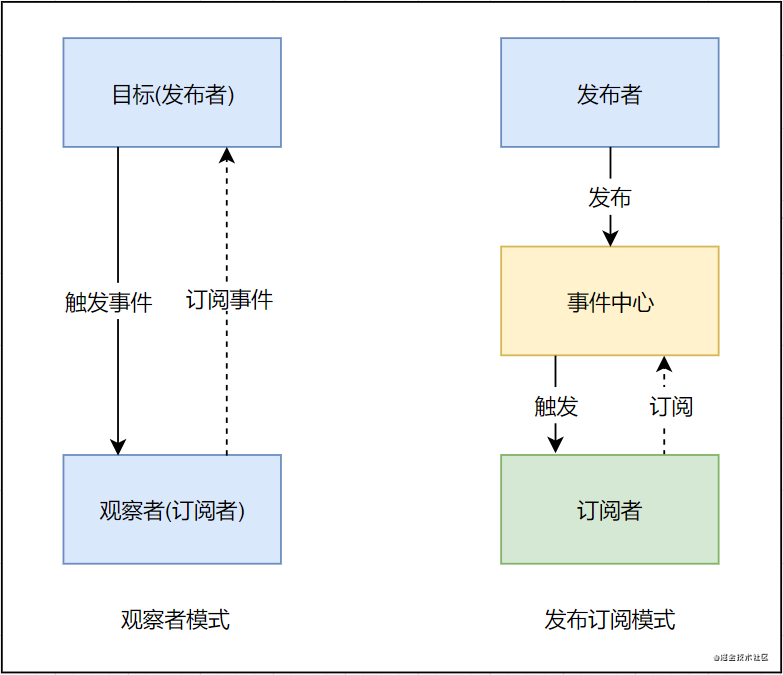
二、Vue 响应式原理模拟
1. Vue
功能 负责接收初始化的参数(选项) 负责把 data 中的属性注入到 Vue 实例,转换成 getter/setter 负责调用 observer 监听 data 中所有属性的变化 负责调用 compiler 解析指令/插值表达式 结构
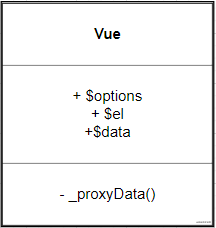
实现
class Vue {
constructor (options) {
// 1. 保存选项的数据
this.$options = options || {}
this.$data = options.data || {}
const el = options.el
this.$el = typeof options.el === 'string' ? document.querySelector(el) : el
// 2. 负责把 data 注入到 Vue 实例
this._proxyData(this.$data)
// 3. 负责调用 Observer 实现数据劫持
new Observer(this.$data)
// 4. 负责调用 Compiler 解析指令/插值表达式等
new Compiler(this)
}
_proxyData (data) {
// 遍历 data 的所有属性
Object.keys(data).forEach(key => {
Object.defineProperty(this, key, {
get () {
return data[key]
},
set (newValue) {
if (data[key] === newValue) {
return
}
data[key] = newValue
}
})
})
}
}
2. Observer
功能 负责把 data 选项中的属性转换成响应式数据 data 中的某个属性也是对象,把该属性转换成响应式数据 数据变化发送通知 结构

实现
// 负责数据劫持
// 把 $data 中的成员转换成 getter/setter
class Observer {
constructor(data) {
this.walk(data)
}
// 1. 判断数据是否是对象,如果不是对象返回
// 2. 如果是对象,遍历对象的所有属性,设置为 getter/setter
walk(data) {
if (!data || typeof data !== 'object') {
return
}
// 遍历 data 的所有成员
Object.keys(data).forEach(key => {
this.defineReactive(data, key, data[key])
})
}
// 定义响应式成员
defineReactive(data, key, val) {
const that = this
// 如果 val 是对象,继续设置它下面的成员为响应式数据
this.walk(val)
Object.defineProperty(data, key, {
configurable: true,
enumerable: true,
get() {
return val
},
set(newValue) {
if (newValue === val) {
return
}
// 如果 newValue 是对象,设置 newValue 的成员为响应式
that.walk(newValue)
val = newValue
}
})
}
}
3. Compiler
功能 负责编译模板,解析指令/插值表达式 负责页面的首次渲染 当数据变化后重新渲染视图 结构
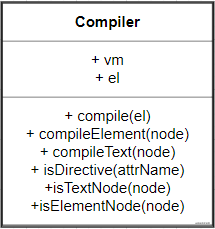
实现
① compile()
// 负责解析指令/插值表达式
class Compiler {
constructor(vm) {
this.vm = vm
this.el = vm.$el
// 编译模板
this.compile(this.el)
}
// 编译模板
// 处理文本节点和元素节点
compile(el) {
const nodes = el.childNodes
Array.from(nodes).forEach(node => {
// 判断是文本节点还是元素节点
if (this.isTextNode(node)) {
this.compileText(node)
} else if (this.isElementNode(node)) {
this.compileElement(node)
}
if (node.childNodes && node.childNodes.length) {
// 如果当前节点中还有子节点,递归编译
this.compile(node)
}
})
}
// 判断是否是文本节点
isTextNode(node) {
return node.nodeType === 3
}
// 判断是否是属性节点
isElementNode(node) {
return node.nodeType === 1
}
// 判断是否是以 v- 开头的指令
isDirective(attrName) {
return attrName.startsWith('v-')
}
// 编译文本节点
compileText(node) {
}
// 编译属性节点
compileElement(node) {
}
}
② compileText()
// 编译文本节点
compileText(node) {
const reg = /\{\{(.+)\}\}/
// 获取文本节点的内容
const value = node.textContent
if (reg.test(value)) {
// 插值表达式中的值就是我们要的属性名称
const key = RegExp.$1.trim()
// 把插值表达式替换成具体的值
node.textContent = value.replace(reg, this.vm[key])
}
}
③ compileElement()
负责编译元素的指令 处理 v-text 的首次渲染 处理 v-model 的首次渲染
// 编译属性节点
compileElement(node) {
// 遍历元素节点中的所有属性,找到指令
Array.from(node.attributes).forEach(attr => {
// 获取元素属性的名称
let attrName = attr.name
// 判断当前的属性名称是否是指令
if (this.isDirective(attrName)) {
// attrName 的形式 v-text v-model
// 截取属性的名称,获取 text model
attrName = attrName.substr(2)
// 获取属性的名称,属性的名称就是我们数据对象的属性 v-text="name",获取的是name
const key = attr.value
// 处理不同的指令
this.update(node, key, attrName)
}
})
}
// 负责更新 DOM
// 创建 Watcher
update(node, key, dir) {
// node 节点,key 数据的属性名称,dir 指令的后半部分
const updaterFn = this[dir + 'Updater']
updaterFn && updaterFn(node, this.vm[key])
}
// v-text 指令的更新方法
textUpdater(node, value) {
node.textContent = value
}
// v-model 指令的更新方法
modelUpdater(node, value) {
node.value = value
}
4. Dep
功能 收集依赖,添加观察者(watcher) 通知所有观察者 结构

实现
class Dep {
constructor() {
// 存储所有的观察者
this.subs = []
}
// 添加观察者
addSub(sub) {
if (sub && sub.update) {
this.subs.push(sub)
}
}
// 通知所有观察者
notify() {
this.subs.forEach(sub => {
sub.update()
})
}
}
// 以下代码在 Observer 类中 defineReactive 方法中添加
// 创建 dep 对象收集依赖
const dep = new Dep()
// getter 中
// get 的过程中收集依赖
Dep.target && dep.addSub(Dep.target)
// setter 中
// 当数据变化之后,发送通知
dep.notify()
5. Watcher
功能 当数据变化触发依赖, dep 通知所有的 Watcher 实例更新视图 自身实例化的时候往 dep 对象中添加自己 结构
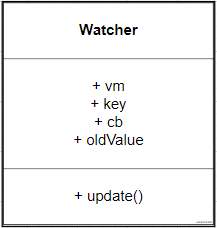
实现
class Watcher {
constructor(vm, key, cb) {
this.vm = vm
// data 中的属性名称
this.key = key
// 当数据变化的时候,调用 cb 更新视图
this.cb = cb
// 在 Dep 的静态属性上记录当前 watcher 对象,当访问数据的时候把 watcher 添加到dep 的 subs 中
Dep.target = this
// 触发一次 getter,让 dep 为当前 key 记录 watcher
this.oldValue = vm[key]
// 清空 target
Dep.target = null
}
update() {
const newValue = this.vm[this.key]
if (this.oldValue === newValue) {
return
}
this.cb(newValue)
}
}
// 在 compiler.js(即Compiler类) 中为每一个指令/插值表达式创建 watcher 对象,监视数据的变化
compileText(node) {
const reg = /\{\{(.+?)\}\}/
const value = node.textContent
if (reg.test(value)) {
const key = RegExp.$1.trim()
node.textContent = value.replace(reg, this.vm[key])
// 编译差值表达式中创建一个 watcher,观察数据的变化
new Watcher(this.vm, key, newValue => {
node.textContent = newValue
})
}
}
// 因为在 textUpdater等中要使用 this
updaterFn && updaterFn.call(this, node, this.vm[key], key)
// v-text 指令的更新方法
textUpdater(node, value, key) {
node.textContent = value
// 每一个指令中创建一个 watcher,观察数据的变化
new Watcher(this.vm, key, value => {
node.textContent = value
})
}
// 视图变化更新数据
// v-model 指令的更新方法
modelUpdater(node, value, key) {
node.value = value
// 每一个指令中创建一个 watcher,观察数据的变化
new Watcher(this.vm, key, value => {
node.value = value
})
// 监听视图的变化
node.addEventListener('input', () => {
this.vm[key] = node.value
})
}
三、总结
1. 两个问题你会了吗
给属性重新赋值成对象,是否是响应式的? 给 Vue 实例新增一个成员是否是响应式的?
2. 通过下图回顾整体流程
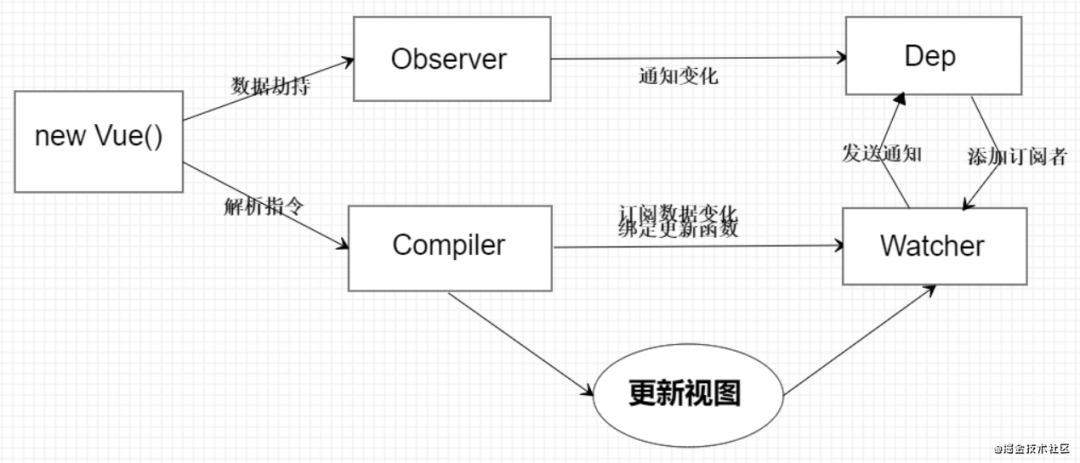
3. Vue
记录传入的选项,设置 data/data/data/el 把 data 的成员注入到 Vue 实例 负责调用 Observer 实现数据响应式处理(数据劫持) 负责调用 Compiler 编译指令/插值表达式等
4. Observer
数据劫持 负责把 data 中的成员转换成 getter/setter 负责把多层属性转换成 getter/setter 如果给属性赋值为新对象,把新对象的成员设置为 getter/setter 添加 Dep 和 Watcher 的依赖关系 数据变化发送通知
5. Compiler
负责编译模板,解析指令/插值表达式 负责页面的首次渲染过程 当数据变化后重新渲染
6. Dep
收集依赖,添加订阅者(watcher) 通知所有订阅者
7. Watcher
自身实例化的时候往dep对象中添加自己 当数据变化dep通知所有的 Watcher 实例更新视图
支持原创,请勿抄袭
The End
欢迎自荐投稿到《前端技术江湖》,如果你觉得这篇内容对你挺有启发,记得点个 「在看」哦
点个『在看』支持下 
评论
